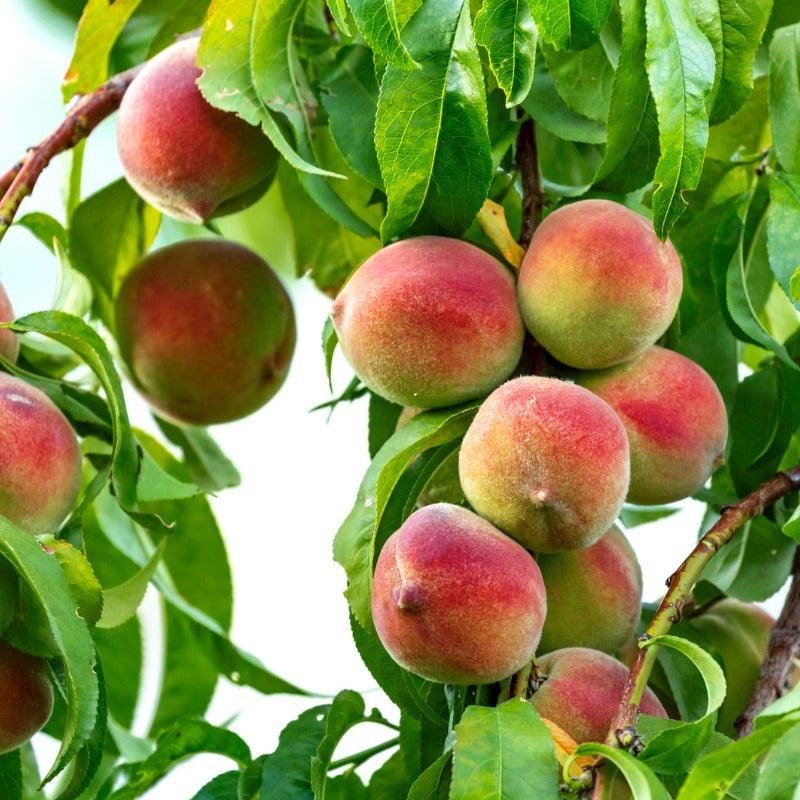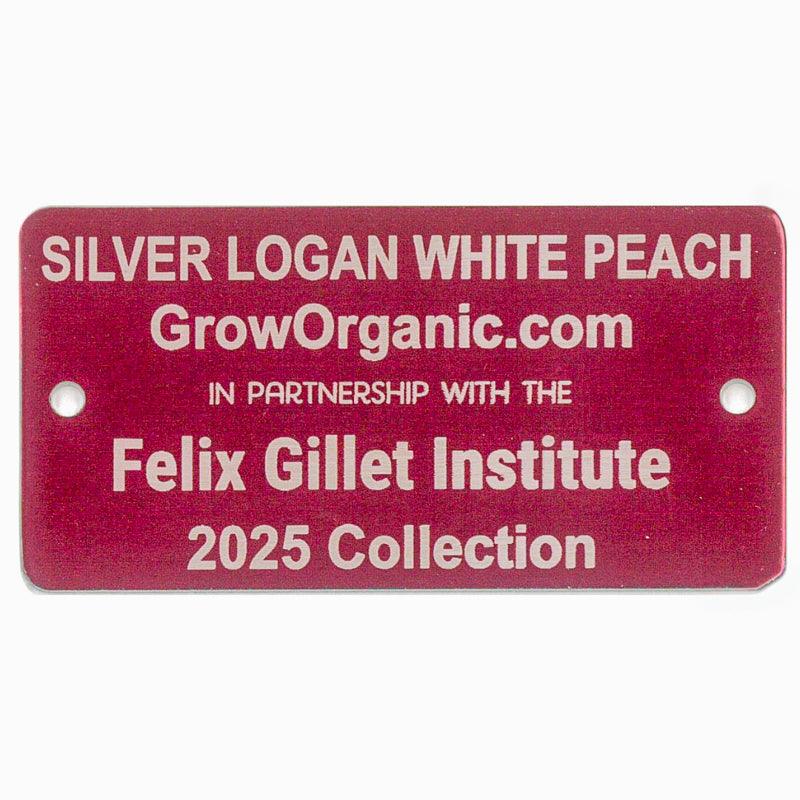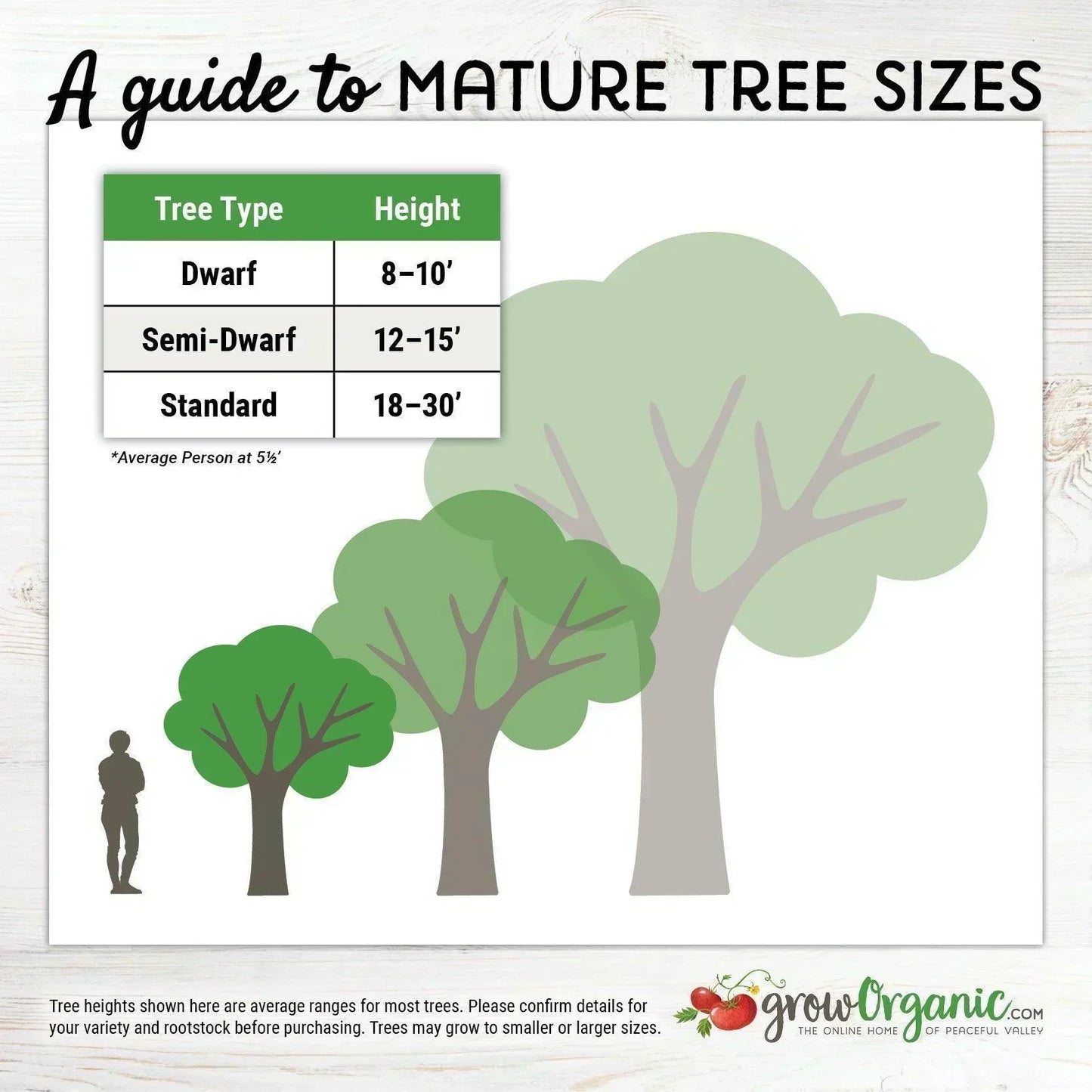Item Number: FT377
Silver Logan White Peach Tree
Popular for excellent quality, superior flavor
Every rare tree purchase supports historical orchard preservation
Limited availability—reserve up to 5 rare trees per order while supplies last
Each handpicked tree includes a durable etched metal display tag.
Standard on Lovell Rootstock
The Silver Logan Peach tree is a remarkable heirloom variety that has captivated fruit lovers for decades. Known for its firm, juicy, and exquisitely flavored white peaches, this tree is a valuable addition to any backyard orchard. Its historical significance, combined with its exceptional fruit quality, makes the Silver Logan Peach tree a must-have for those who appreciate heirloom varieties and the rich legacy of fruit cultivation.
Historical Background
The Silver Logan Peach is a relatively modern heirloom variety, discovered as a seedling in California in the 1950s. Despite its relatively recent introduction, it quickly gained popularity due to its superior flavor and excellent fruit quality. This peach has since become a favorite among backyard growers and fruit connoisseurs alike, celebrated for its firm, juicy flesh and perfect balance of sweetness and acidity.
While the Silver Logan Peach tree is a more recent addition to the pantheon of heirloom fruits, it carries the spirit of the historical trees that have been cultivated in California for over a century. The legacy of Felix Gillet, a pioneering horticulturist who introduced many fruit and nut trees to the American West in the 19th century, looms large over the Silver Logan Peach. Gillet's work laid the foundation for the fruit-growing industry in California, and the Silver Logan Peach tree is a testament to the enduring appeal of high-quality, carefully cultivated fruit.
How to Grow a Silver Logan Peach Tree
Growing a Silver Logan Peach tree requires attention to detail and a commitment to providing the best possible conditions for the tree to thrive. By following these guidelines, you can cultivate a healthy tree that produces abundant, flavorful peaches.
- Climate and Location: The Silver Logan Peach tree thrives in temperate climates with warm summers and cold winters. Like most peach trees, it requires a certain number of chilling hours (exposure to temperatures between 32°F and 45°F) during the winter to break dormancy and ensure proper fruiting. This makes the Silver Logan Peach tree well-suited to regions with distinct seasons, such as the northern and central parts of California. When choosing a planting site, select a location that receives full sun, as this will help the tree produce the best quality fruit.
- Soil Requirements: The Silver Logan Peach tree prefers well-drained, sandy loam soils with a pH level between 6.0 and 7.0. While it can tolerate a range of soil types, good drainage is essential to prevent root rot and other moisture-related issues. Before planting, it's beneficial to amend the soil with organic matter, such as compost or well-rotted manure, to improve its structure and fertility. This will provide the tree with the nutrients it needs to establish strong roots and grow vigorously.
- Planting: When planting a Silver Logan Peach tree, dig a hole that is twice as wide and just as deep as the tree's root ball. Place the tree in the hole, ensuring that the graft union (where the rootstock meets the scion) is above the soil line. Fill the hole with soil, gently firming it around the roots to eliminate air pockets. After planting, water the tree thoroughly to help settle the soil and provide moisture to the roots.
- Watering: Consistent watering is crucial for the health of the Silver Logan Peach tree, especially during its first few years of growth. Keep the soil evenly moist but not waterlogged. A deep watering once a week is generally sufficient, although more frequent watering may be necessary during hot, dry periods. Mulching around the base of the tree can help retain soil moisture, regulate soil temperature, and reduce weed competition.
- Pruning: Pruning is essential for maintaining the health and productivity of the Silver Logan Peach tree. Prune the tree during its dormant season, typically in late winter, to remove dead, diseased, or crossing branches. This improves air circulation within the canopy, reducing the risk of fungal diseases. Pruning also helps shape the tree and encourages the growth of strong, fruit-bearing branches. For best results, aim to create an open center or vase shape, which allows sunlight to penetrate the canopy and reach the developing fruit.
- Fertilization: Regular fertilization supports the tree's growth and fruit production. Apply a balanced fertilizer in early spring, just as new growth begins, to provide the tree with essential nutrients. Additional feedings can be made throughout the growing season, particularly if the tree shows signs of nutrient deficiency, such as yellowing leaves or stunted growth. However, avoid excessive nitrogen, as this can lead to excessive vegetative growth at the expense of fruit production.
Fruit Production
The Silver Logan Peach tree is renowned for its reliable and abundant fruit production. The tree typically begins bearing fruit within 3 to 4 years of planting, with full production occurring once the tree reaches maturity. The peaches are large, firm, and juicy, with a delightful balance of sweetness and acidity. The white flesh of the Silver Logan Peach is meltingly tender, making it a favorite for fresh eating, desserts, and preserves.
- Pollination: The Silver Logan Peach tree is self-pollinating, meaning it does not require a second tree for cross-pollination. However, planting more than one peach tree in close proximity can improve overall fruit set and yield, as it encourages better pollinator activity. Bees and other pollinators play a crucial role in this process, so maintaining a pollinator-friendly environment around your orchard is beneficial.
- Thinning: Once the tree begins to set fruit, it may produce more peaches than it can adequately support. Thinning the fruit, or selectively removing some of the young peaches, can help the remaining fruit grow larger and more flavorful. Thin the fruit when it is about the size of a marble, leaving about 6 to 8 inches of space between each peach. This practice reduces competition for nutrients and energy, resulting in higher-quality fruit.
Harvesting Peaches
Harvesting peaches at the right time ensures that they have reached their full flavor and sweetness. The Silver Logan Peach typically ripens in mid to late summer, depending on local climate conditions.
- Harvest Timing: To determine if a peach is ready to harvest, gently press the fruit with your thumb. A ripe peach will yield slightly to pressure and will have a sweet fragrance. The fruit should also easily detach from the branch with a slight twist. It's best to harvest peaches in the morning when temperatures are cooler, as this helps preserve their flavor and firmness.
- Handling: The Silver Logan Peach is known for its delicate flesh, which bruises easily. Handle the fruit carefully during harvest to avoid damaging the peaches. Place the harvested fruit in shallow containers, being careful not to stack them too high, as this can lead to bruising and spoilage.
- Post-Harvest Care: After harvesting, peaches can be enjoyed fresh or preserved for later use. If you have a large harvest, consider freezing, or making peach preserves to enjoy the fruit throughout the year. Proper storage is key to maintaining the quality of the fruit. Store fresh peaches in a cool, dry place or refrigerate them to extend their shelf life. When handled and stored correctly, peaches can be kept for several days, allowing you to savor their sweetness long after the harvest season has ended.
Conclusion
The Silver Logan Peach tree is a unique and cherished heirloom variety that offers both historical significance and exceptional fruit quality. By following the guidelines for planting, care, and harvesting, you can enjoy the sweet rewards of this remarkable peach tree. Whether you're growing the tree for its connection to Felix Gillet and the rich horticultural history of California or simply for its delicious fruit, the Silver Logan Peach tree is sure to be a valuable addition to your garden or orchard. Its firm, juicy, and flavorful peaches are a testament to the enduring appeal of heirloom varieties and the joys of homegrown fruit.
For more information about different types of rootstocks and how they influence tree size and growth, see our Tree Rootstock Characteristics Chart.




Check Your Zone Compatibility:
Compatible with your zone.
Growing Zone for

Our Guarantee To You
Since 1976, we've served our customers at every stage of growing. Please contact us at any time. We are happy to support and assist you.
Shipping Information
Shipping Information
Cannot ship to the following states: HI, AK, PR, GU, VI
Shipping Weight: 5.0 lb
Dimensions: 47.5"L x 7.3"W x 2.75"H
Features
Features
- Bare Root
- Flavor Pick
- Freestone
- Self-fruitful
- Suited to Cold Climates
Characteristics
Characteristics
Planting & Care
Planting & Care
Useful Information
Useful Information
Guarantee
Guarantee
Limited Dormant Tree & Plant Guarantee
* Claim deadline is June 15th
We guarantee that your dormant tree or plant will arrive in good, viable condition. If your tree arrives in substandard condition, notify us within 3 days of delivery. Please email pictures of the box, inside packaging, the tree and its roots to helpdesk@groworganic.com. We will investigate your claim and process a request to exchange or refund the damaged product.
If your dormant tree or plant has not grown new leaves by June 15th, you may be eligible for our Limited Dormant Tree & Plant Guarantee. This guarantee provides for a store credit for the purchase price of the tree, excluding shipping. Please see the Instructions below.
Important Dates:
- April 1st Dormant trees/plants must be planted in the ground
- May 15th Perform scratch test, if no new leaves have grown
- June 15th Deadline to apply for a dormant tree/plant credit
All required documentation must be received by June 15th for your claim to be considered. Claims or documentation received after June 15th will be denied, without exception. Instructions listed below
Terms and Conditions
We cannot guarantee that your tree or plant will remain alive and healthy after it is received, or bear fruit as there are too many variables in your environment that are beyond our control (i.e. soil preparation, weed and pest control, proper irrigation, chill hours, compatible hardiness for your growing zone, proper choice of pollinator, extreme weather, rodent damage, disease, etc.).
We cannot guarantee that we will be able to provide a replacement tree/plant of the same species either that same growing season or in future years. Customers are responsible for all shipping fees associated with replacement trees and plants.
If we determine that the tree you purchased directly from us is not viable, we will issue you a store credit (not a refund) for the purchase price of the affected dormant tree or plant. Shipping is not included in the dormant tree/plant guarantee. Store credits can be used to purchase any product we sell and are valid for use only until July 1st of the following year.
Historically, 98% of our dormant trees and plants grow and thrive when they have been cared for and planted using our growing guides. Dormant trees and plants must be planted in the ground by April 1st in order to be eligible for credit. If the ground in your area is still frozen solid, you may temporarily plant your tree or plant in a pot.
Potted, non-dormant trees or plants are excluded from this guarantee as they are not dormant at the time of shipment. Evergreen trees such as citrus, avocado and olive trees are not available for credit under the Dormant Tree and Plant Guarantee.
Instructions
We guarantee that your dormant fruit tree or plant will leaf out, if you care for it according to our growing guides. In the unlikely event that your dormant tree or plant does not have leaves by May 15th, follow these simple steps to apply for a store credit:
Before you call or email, please perform a “scratch test” to determine if the tree or plant is still alive. This video shows how to check for live tissue under the bark. Scratch tests need to be done a few inches above and below the graft.
Green Cambium Layer / Living Trees
If the cambium layer under the bark is green, give your tree a little more time. It is still alive, but hasn’t come out of dormancy yet. Check to make sure that it is getting the right amount of deep root water, enough sunlight and that the weather is warm enough for that type of tree/plant to come out of dormancy. Every tree has its own personality and will come out of dormancy at different times. Be sure to submit the required documentation listed below by June 15th, if it doesn’t grow leaves.
Brown Cambium Layer / Dead Trees
If the scratch test shows a brown cambium layer or if your dormant tree/plant doesn’t have leaves by June 1st, please email us at helpdesk@groworganic.com. All required documentation listed below must be received by June 15th for your claim to be considered. To be considered for the guarantee claim, all required documentation must be received by June 15th. Incomplete submissions will be denied.
Required Documentation
- Order number
- Name of dormant tree/plant and the quantity affected
- Photos of each tree or plant showing:
- The roots (tree or plant must be pulled out of the ground)
- The scratch test areas
- The entire tree/plant
We reserve the right to not issue credit for items that have already been replaced. We also reserve the right to require photographic evidence that the tree/plant was not killed by root rot, rodent or mechanical damage.
Share





I am so pleased with this tree! It arrived in March with a nice thick trunk and looking really healthy. Since then, it has grown a ton of new leaves and branches and is a fantastic addition to our backyard! These Felix Gillet trees are definitely worth the investment!






